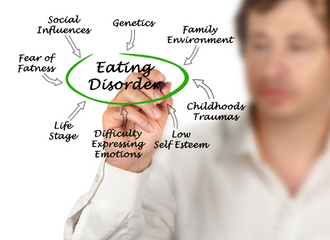Written by: Jessica Berens, RD (she/her)
Regional Nutrition Manager & Dietitian at The Renfrew Center
The term “diet culture” refers to a set of beliefs that value thinness, promote fat loss, demonize certain foods, idealize others, and equate appearance, weight and shape with health and well-being. Diet culture is ingrained in current culture and can be found anywhere from the news to social media and even in conversations between family, friends, and loved ones. A question many people ask is, “if diet culture is so common, why is it seen as a bad thing?”
Diet culture hides under the guise of health, meaning it is portrayed as health-focused yet promotes disordered behaviors, and many times extreme beliefs about food, exercise, and our bodies. We see diet culture promoted in articles about current diet trends, news segments about a celebrity’s “body transformation”, and advertisements for “detox” pills, “fat burning” teas, or juice “cleanses”.
Diet culture also seeps into messaging towards younger generations. Toys and characters are made with societal ideals of the “perfect” body and lack representation of diverse, marginalized groups. Some teachers assign projects that require adolescent and teen students to track their calories over a week and weigh themselves to calculate BMI, sometimes in front of their peers.
Why Diet Culture Is So Pervasive
Diet culture thrives on one simple premise: your body is the problem, and it needs “fixing”. In creating a dynamic where we feel as if our body needs to constantly change, diet culture also creates a profitable market.
According to Allied Market Research, the weight loss, weight management, and diet industry is valued at $192.2 billion in 20191. Research has shown that diets don’t work in the long term, and the profit margin reflects that. An industry this large and this profitable thrives off the vicious cycle so many are in: believing our bodies aren’t good enough, trying to find a way to “fix” them, starting a new diet, failing to maintain the extreme and unsustainable nature of that diet, re-gaining all the weight, blaming our own lack of discipline, and ultimately feeling intense shame and guilt.
This feeling of failure and the belief that we simply did not have enough “will power” starts the cycle all over again. This foundation of diet culture not only keeps us feeling as if our body is the problem, unworthy of love as is and in need of change, but also creates a profitable business in our capitalist society.
The Dichotomy of Diet Culture: Good vs. Bad Food & Nutrition
Diet culture is seen most often in the nutrition and fitness industries. Tips such as “eat this, not that” are some of the most common diet culture taglines. Often these tips perpetuate the idea that certain food groups are better than others and we should be reducing options and limiting intake.
For example, a common “this, not that” involves using Greek yogurt instead of mayo. In this example, dietary fat is labeled to be a “bad” thing that needs to be replaced, despite the important role dietary fats serve in our bodies. Dietary fats help with the absorption of fat-soluble vitamins (A, D, E, and K), protect our stomach lining from irritants, aid in the building cell membranes and cells walls, and serve as a source of energy for the body.
Tips to “eat this, not that” demonize certain food groups, induce guilt around some foods or key nutrients, and minimize the important role of variety in our nutritional intake.
This black and white thinking of “good versus bad” and “healthy versus unhealthy” plays on the very premise of diet culture: that we are “good” as long as we eat certain foods, stay away from others, and exercise in certain ways. These rigid thoughts can lead to taking a more extreme approach to exercise and restrictive approach to food if the desired outcome, which is typically weight loss, is not achieved.
As mentioned above, when we believe we are “failing” to follow these rigid rules, it keeps us searching for new diet trends and stuck in the diet culture cycle.
8 Ways to Reduce Diet Culture Talk at Home
So many want to avoid diet culture in the home, yet it often thrives in our home environment. If conversations revolve around food judgments, the size or shape of bodies, or place value on what we did or didn’t eat, then diet culture is alive and well in your home! Here are eight immediate ways you can reduce the presence of diet culture in your home and everyday life.
#1: Stop labeling foods as “good” or “bad”
One way to start changing the black and white thinking related to food is to remember that all foods have a benefit for the body. By focusing on what the food provides, we can start to view all food more neutrally.
For example, a side salad provides our body with fiber, an array of vitamins and minerals, and the dressing on the salad is a dietary fat that helps us to absorb some of the nutrients in the salad greens. A side of fries provides our body with key nutrients, too. Fries provide carbohydrates, which are an energy source for the body, and contain B vitamins, vitamin C, and potassium. Both provide functional nutrients for the body and are a normal part of variety.
We cannot forget about enjoyment and satiety with food! By removing the labels and judgments we place onto foods such as “good, bad, healthy, unhealthy, should eat, or shouldn’t eat,” we can notice our own preferences for flavors and food combinations. By having enough food at meals and snacks and by eating foods we like, we will not only meet our body’s diverse nutritional needs through variety, but also feel more sustained and satisfied after eating.
#2: Avoid conversations focused on body size and shape
Conversations around body size promote the concept that body shape and size matter as much or more than physical and mental health. These comments often occur unconsciously. Comments such as “that ___ makes you look fit” or “you look great, have you lost weight?” reinforce the message that our body size matters to those we love or can impact our ability to be loved. These comments also focus on thinness, or a smaller body, as the metric for wellness, attractiveness or worth.
We can change this messaging by stopping or redirecting conversations at home related to body size. Avoiding commentary around your own or other’s bodies reduces the emphasis on size and shifts attention to more meaningful and connective topics in our relationships. Also, try choosing compliments that are focused on the person’s inner qualities and values rather than their body. For example, “that outfit reflects your personality so well!” or “you really light up the room”.
#3: Inform others about diet culture and the impact it has on you
Lastly, to reduce the presence of diet culture in your life, it is important to educate friends, family, and loved ones. One way to start the conversation is to provide an example of how diet culture has impacted you.
For example, “I’m working to challenge diet culture in my life. For me, this looks like talking less judgmentally about food at mealtimes or with my friends. I’m wondering if you notice any influences of diet culture in our relationship/in your life?”. Starting these conversations helps to increase awareness of something that is part of mainstream society. Over time, we can reduce the frequency of diet culture language in our relationships and help redirect any unhelpful or harmful comments and conversations.
#4: Checking Bias
We discussed the key areas of diet culture, but often, diet culture thrives in less noticeable spaces. Judging someone’s size, what they’re eating based on their size, or making assumptions about someone’s health and habits from their appearance are biases that align with diet culture. According to the National Institute of Health, implicit bias is “subconscious feelings, attitudes, prejudices, and stereotypes an individual has developed due to prior influences and imprints throughout their lives. Individuals are unaware that subconscious perceptions, instead of facts and observations, affect their decision-making.”2 These biases about body size are formed from years of diet culture influence and become ingrained into subconscious judgments.
This leads to a question many of you may be thinking: “If our implicit biases are often subconscious and influence how we view ourselves and others then how do we begin to notice them?”. The first way to increase awareness of biases is by taking the Implicit Association Testing (IAT) through Project Implicit. Another way to check your biases is to begin asking yourself “Do I know this to be true about X person/myself or am I making an assumption?”. This question can help you slow down and explore how you came to this conclusion about yourself and others. You can also ask this question as it relates to food and body size. This allows the opportunity to explore if the thought you had is supported by science or something you’ve learned from exposure to years of diet culture.
#5: Look for weight-neutral medical providers
When working to dismantle diet culture in your life, finding providers who practice from a weight-inclusive lens is key. These providers are more likely to understand the nuances of living in a diet-culture-driven society. This means that medical recommendations from these providers are more likely to be free of bias regarding an individual’s size. They focus on person-centered care, treating the individual rather than just addressing symptoms, and they avoid prescribing dieting and weight loss for health conditions that affect individuals of all sizes.
This is especially important when it comes to nutrition recommendations. Often, restricting calories is recommended for folks in large bodies when these same behaviors are deemed as disordered in the mental health field. This is a prime example of diet culture thriving in healthcare services. A person should not receive a different nutrition recommendation or treatment based on the size of their body. All bodies are deserving of consistent nutrition, which includes a variety of foods and food groups, while also considering any medical diagnoses or food allergies.
A list of weight-inclusive providers can be found here: https://asdah.org/listing/. If you are unable to find weight-inclusive providers in your area or ones covered by your insurance, advocate for yourself by asking questions such as: “Is this a recommendation you would give to any patient with my medical history or condition regardless of their body size?”, “Do you need to take my weight today for ____ services I’m receiving?”, “What other medical interventions aside from weight loss can help ___?”.
#6: When Intuitive Eating is a diet in disguise
Intuitive eating has gained popularity over the past 15-20 years. The aim of intuitive eating is to “provide a new way of eating that is ultimately struggle-free and healthy for the mind and body”3. Intuitive eating is complex and includes ten nuanced principles focused on dismantling diet culture, making peace with food, and fostering body respect. Unfortunately, the multi-billion-dollar diet industry has co-opted the term for their financial gain.
Intuitive eating has been oversimplified into the advice of “eat when you’re hungry and stop when you’re full”. This oversimplification of ‘intuitive eating’ focuses solely on the hunger-fullness principles of intuitive eating as a method to eat less and “control cravings,” creating doubt around what feeling hungry truly means. If the journey of intuitive eating leads to restrictive behaviors, increased stress around food, body hatred, and patterns of over and under feeding, then the concepts of intuitive eating have been manipulated to be yet another marketable, trending diet.
If you are interested in learning more about intuitive eating you can read more about it here: https://renfrewcenter.com/intuitive-eating-eating-disorders-principles-treatment-challenges-3-ways-to-implement/
#7: The value of redirection
A question I hear often is, “what do I do if I’m eating around someone I don’t want to tell about my recovery or educate about diet culture?”. This is a situation many people face, whether it’s around a coworker you don’t often eat with or an extended family member you see only once a year during the holidays.
If someone is discussing a diet or avoiding certain foods during a meal, try introducing a new topic of conversation. While this may seem like a simple tip, it can be quite challenging in the moment. There is often a fear of appearing rude by making an abrupt topic change, a desire to feel “normal” and join in on the diet talk, or discomfort about how to shift the flow of conversation. It can help to come prepared with 2-3 ideas of neutral topics in case you need to change the conversation more than once.
One way to do this is by saying something like, “I read something interesting today,” or “I forgot to share this thing happened this week,” before introducing your neutral conversation topic. Redirecting the conversation onto a neutral topic can refocus it away from food or body-related comments and foster a sense of community and connection. The hope is for mealtime conversations to be about building relationships, catching up on the day, or decompressing with loved ones, rather than a space to reinforce more diet talk.
#8: Internal Boundaries: When the diet talk continues
Finally, I’ll address the thought we are all having: what if none of this works and the diet culture talk continues? Educating loved ones, redirecting conversations, finding supportive medical providers, and dismantling our own diet beliefs are all great, but making change is a slow process. It is also possible that those in our environment may not change or adhere to the boundaries that we set. This does not mean things cannot change for you.
This is where we can explore internal boundaries – tools and skills we can use to take care of ourselves when diet culture is alive and well in our environment. An internal boundary might involve journaling before and after an experience to process it in an upcoming therapy session, having a support person on standby to text or call after the interaction, making plans outside of mealtimes with a certain friend to reduce diet talk, or using cognitive reappraisals to challenge comments about food or weight made by others.
A cognitive reappraisal about food can involve identifying the scientific functions of a food, such as the example mentioned earlier: “Fries provide carbohydrates, which serve as an energy source for the body, and they also contain B vitamins, vitamin C, and potassium.” Alternatively, it can be a simple reminder that there is no such thing as good or bad food. Reappraisals about food do not have to focus solely on the food itself; they can also include statements like, “I don’t feel good when I engage in the things this person is discussing,” or “I’ve learned that what this person says isn’t healthy or helpful for me and my body”. These reappraisals are reminders we can mentally call upon, even in the moment when those around us are engaging in diet talk.
Conclusion
Even when we are aware of the negative impacts of diet culture, it can be challenging to dodge its strong societal presence. Diet culture thrives by re-branding itself to sell us the same idea over and over again: that something about us is wrong and needs fixing. The more we become aware of the direct impacts of diet culture, the more we will start to notice the subtle ways it remains alive and thriving in our world.
If you feel like it is impossible to escape, remember starting small can help to remove diet culture’s larger presence in our lives. Aiming to free ourselves from the food judgments, find neutrality and respect for our bodies, and improve health in an individualized way takes time and practice. Be compassionate with yourself through the journey and remember diet culture thrives on our humanness, as all humans have insecurities. The diet industry profits from us feeling we are “not enough” or “in need of fixing,” but you are already enough, worthy, and deserving of respect just as you are.
References:
- https://www.alliedmarketresearch.com/weight-loss-management-diet-market
- https://www.ncbi.nlm.nih.gov/books/NBK589697/#:~:text=Implicit%20bias%20includes%20the%20subconscious,%2C%20affect%20their%20decision%2Dmaking.
- Tribole E, Resch E. Intuitive Eating. 4th ed. St. Martin’s Essentials.



